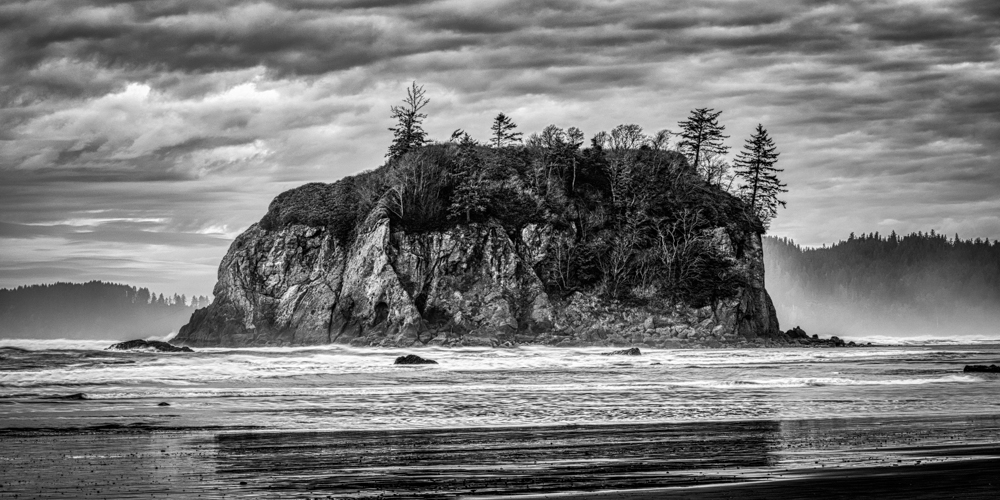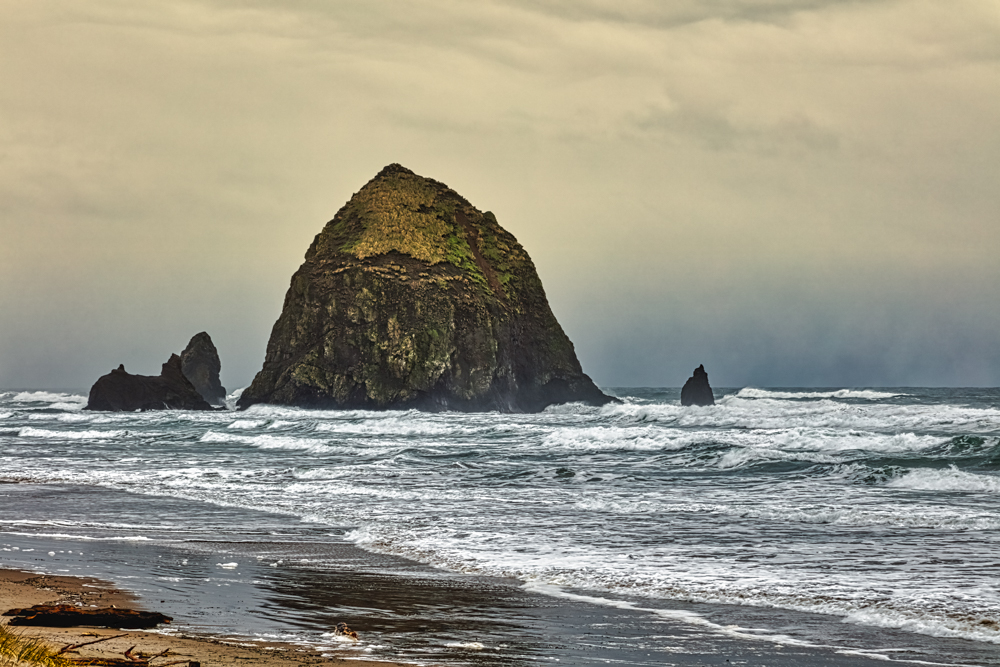As promised, we are going to take a detour this month and go off-island. Our destination? There are actually two of them – Ruby Beach and Cannon Beach – with a special emphasis on sea stacks, a geological phenomenon which makes scenic views of the Pacific Ocean yet more spectacular. We will start with Ruby Beach on the Olympic Peninsula in Washington and end at Cannon Beach on the Oregon coast.
But first, a short refresher course in Geology 101. A sea stack (or just “stack”) is a geological landform consisting of a steep and often vertical column of rock in the sea near a coast. They are formed over time when a headland is eroded by the force of waves crashing against the rock. The force of the water weakens cracks in the headland, eventually causing it to collapse and form free-standing stacks or sometimes even a small island.
Taking Highway 101, the drive from Bainbridge Island to Ruby Beach in the coastal section of Olympic National Park takes approximately three and a half hours. A good place to stretch your legs en route is Lake Crescent, about 30 minutes west of Port Angeles. Once you reach Forks, the former logging town that attained notoriety thanks to the fantasy vampire-themed Twilight novels, you are just 30 minutes away.
Without a doubt, the main selling point of Ruby Beach is its gorgeous, knock-your-socks-off scenery. Combined with the pounding surf and crisp ocean air, this is definitely a place where you can clear your head. On top of that, its iconic sea stacks are both stunning and inspiring, especially towards the end of the day when the lighting becomes more dramatic.
One nice thing about Ruby Beach is its accessibility. The parking lot is located directly off Highway 101, and the easy trail down to the beach takes less than 10 minutes to traverse. Access at the bottom is blocked by many large drift logs but navigating them to reach the pebbly shore is part of the fun. The side image shows what awaits you: a wide, expansive beach, perfect for walking, with a plethora of driftwood – and yes, those amazing sea stacks. Luckily, even though this visit was in early December, we were blessed with pleasant skies and dry weather.
The sea stacks at Ruby Beach are some of the most well-known in the entire country. The above image highlights Abbey Island – so named because early settlers thought the stack looked like a church. Sitting offshore a few hundred feet north of the beach, Abbey Island is home to sea otters and migratory birds, and flanked with starfish and mussels. Those who choose to explore it had best consult their tide tables beforehand to ensure they don’t get stranded! This shot, taken shortly before sunset in late November, well illustrates what I said about dramatic lighting (and a killer cloud layer) being present near the end of the day.

The above image was taken at almost the same time as the previous image – the main difference being that I zoomed in to emphasize the craggy shape and details of Abbey Island. The other difference, of course, is that it’s a black and white interpretation. Do you have a preference between color versus black and white images? My honest answer to this question would be, “It depends.” While sometimes, at least in my subjective mind, there is a clear-cut winner, some images look fantastic in both color and monochrome. In this instance, I think I would have to call it a tie.
Cannon Beach is 14 miles south of Astoria, a quaint town on the Columbia River just a few miles from the Pacific Ocean that is also the oldest American settlement west of the Rockies. The Columbia River forms the western boundary between Washington and Oregon, and if you ever visit this neck of the woods, I heartily recommend that you enter Oregon from the Astoria-Megler Bridge, a four-mile-long truss bridge on Highway 101 that spans the mouth of the river between the two states.
Having experienced Cannon Beach this January for the very first time, I completely understand why National Geographic listed it in 2013 as one of the 100 most beautiful places in the world. Between its stunning coastline views and wide sandy beach, all punctuated by Haystack Rock – at 235 feet the tallest sea stack in the continental United States – the scenery is spectacular. Plus, its charming village can easily be explored on foot, with art galleries, shopping boutiques, fine restaurants, and premier accommodations all within short walking distance of the beach. But while the monolithic Haystack Rock is undoubtedly the centerpiece, the constant roar of the ocean and nonstop crashing waves, along with the omnipresent dune grass and inviting sandy beach, are an impressive supporting cast.
As shown by the above image, the broad girth of the shoreline at Cannon Beach is even wider at low tide. Between the setting sun, the low clumpy clouds, and the patches of blue sky, it was the perfect time to capture reflections in the sand. The tiny walkers in the right center of the image add perspective to the size of Haystack Rock off in the distance.
I’ll admit we had our share of sideways rain while in Cannon Beach, but when there were breaks in the action, there also was plenty of drama in the sky. The above image, which is actually two digital exposures merged together with software to form a single panorama, is aptly called “Tempestuous” because of the crazy clouds and the threatening rainstorm out at sea. Not so many beach walkers this time, however, thanks to the narrow strip between the dune grass and the ceaseless, white-capped waves resulting from the high tide.

Our last image focuses on Haystack Rock under calmer skies. I really don’t understand how scientists calculate these things, but the monolith was supposedly formed by lava flows from eastern Oregon along the route of the Columbia River some 14-15 million years ago. The third tallest sea stack in the entire world, it’s no surprise that Haystack Rock is one of Oregon’s most recognizable attractions (though overall, I’m still partial to Abbey Island at Ruby Beach).
NEXT MONTH: We will return to Bainbridge Island and, with autumn not too far off, display some images of fall colors to demonstrate that New England by no means has a monopoly on such colorful scenery.
PREVIOUS ARTICLES:
Island Images Volume #5
Island Images Volume #4
Island Images Volume #3
Island Images Volume #2
Island Images with Andrew (“Andy”) Bergh

ABOUT ANDREW BERGH: Local artist Andrew (“Andy”) Bergh is a long-time Bainbridge Islander (33+ years), whose successful transition from law to photography began in 2010. After displaying his unique and evocative images at different venues, including the Bainbridge Island Studio Tours, the Saturday Farmers Market, and various local businesses, Andy took the big plunge in September 2018 when he opened his own gallery – Bergh Images – in downtown Winslow. His prints are offered in different mediums, including metal, canvas, and fine art acrylic prints; matted prints; and custom-framed black and white prints. Andy has an online presence at https://berghimages.com/, which also features his entertaining travel blog. The gallery is open every day but Monday, with Andy and his wife Carol regularly participating in the monthly First Friday Art Walks sponsored by the Bainbridge Island Downtown Association.